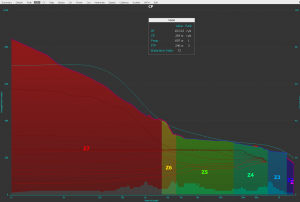
These are usually out and back courses, so you get the benefit of the slope but have to fight it on the way back or vice-versa etc.Īs TrainerRoad uses FTP so heavily, I wanted to ensure I don’t lose heart if I only see modest FTP gains (despite hard training) over the coming months. Most are mildly rolling at times or have long drags of a few miles with gradients between 2% and 4%. I have some very specific goals/times I want to reach on courses that I am now familiar with.

I do want to improve various aspects of my cycling ability this season, but my priority for 5 to 6 months from now is to be much stronger in my Time Trials. It’s one more gizmo to yutz with and wear, but looking at how the power is being generated over the course of an interval set or fartlek ride, in addition to how much power is being generated, could tell you something about how your training is/is not developing the systems that you’re targeting.

On efforts under 1 minute, it would be all about steepening the deoxygenation curve – if that thing is diving down, you would be accessing more and more energy anaerobically, which is what you’d want to do on AC efforts.įor any duration of effort, looking at how quickly oxygenation rates come back up during the recoveries would tell you how/how not your body’s ability to recover and refuel the muscles is coming along – not something we always think about with the focus on watts, watts, watts. On a 3-5 min effort, a slow deoxygenation rate, and shallower dip in the SMO2 curve, for the same power as an effort a few weeks or months earlier, would show that more of the power is being generated aerobically a steeper curve, with higher power, would show the ability to access more of the anaerobic system (also, steeper curves on succeeding intervals in one set would show more aerobic fatigue and a larger dependence on the anaerobic system, even though the power might be the same – conversely, no steepening of the downward curve would show increasing ability to repeat VO2 max efforts without dipping into the anaerobic bank). Looking at the SMO2 and Hg graphs, I can see that not only could I look for improvement in how much power I’m generating on the hard efforts, but also how quickly the SMO2 plunges down on 3-5min intervals, and :30-:60 ones. I’ve done a couple of short interval sessions with the Humon (8 x :30 all out, then 4:30 recovery, and a VO2-focused fartlek ride of four ~ 11min loops of 4min hill, 4min recovery, 1min hill, 2min recovery). In addition to improving your PD curve, I’ll throw looking at deoxygenation/oxygenation rates, and your Hg to SMO2 relationship (the disassociation curve) when using a muscle oxygenation monitor. How you judge your progress however doesn’t just have to be judged on FTP but it’s probably a pretty good marker. There are well documented training programmes of track sprinters and kilo riders completing lots of long distance aerobic training before focussing more on the specific demands of their event as it gets closer.Ĭonversely those who are targeting long distance races might be well served trying to increase short duration power before again becoming more specific towards the goal event.ĭifferent riders will prioritise improvements in different durations dependent on their target events - what gets trained will improve the most - but for most cases if your FTP improves the likelihood is that your abilities at most durations will improve as well. Obviously all of those will have different goals and priorities but not to the exclusion of everything else. However, is this the best in all circumstances? What about the differences between sprinters, long distance athletes, mountain bikers, cyclo cross, Time Trialists etc. It can be as easy or as complicated as you need it to be. You don’t need to use other software to do this though, you can track these figures yourself in any format, a spreadsheet or just writing them down in a chart if you want. One of the advantages of using software like this is that I can track progress over different periods of time, changing the chart to show different periods of time like the ‘seasons’ feature in the TrainerRoad power duration curve chart. Having the trend lines sloping up is always a good thing and will be a marker of progress either positive or negative. I’ve got variations of the chart both for average power over the same durations and similar charts for anaerobic power for shorter durations.

This mostly covers for me the TrainerRoad Traditional Base training programmes. This is my chart for Aerobic Normalised Power from after my last race last year in September - my best power (here displayed weekly) over 20m, 52m, 90m, 2h and 3h durations with trend lines.


 0 kommentar(er)
0 kommentar(er)
